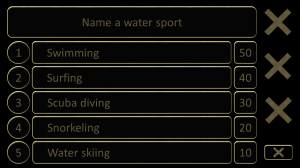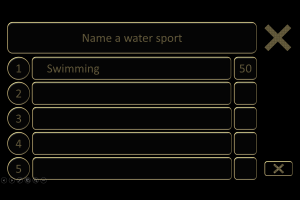This week I thought I would follow up Jeopardy with another classroom adaptation. Family Feud was a game show where two families competed against each other.
The show surveyed 100 people and the families had to guess the most popular answers from the survey.
There are two ways you could play Family Feud in the classroom.
The first way is to conduct a student survey and use their answers to play the game. The benefit to this is that the students are making material for themselves and are involved in the class. The downside to this is that it requires more preparation time and the students may have more of an idea about what the answers could be.
The second way is to choose five answers at random and give the students some thinking time before you start the game. The game can be played before the students conduct a class survey.
Download the Game
Click on Family Feud to download the game or visit the downloads page.
About the Game
The template shows a question and five answers. Each answer has a point value assigned to it. On the right-hand side there are three crosses to represent incorrect answers.

Click on the slideshow tab on the toolbar and click on the icon to ‘start slideshow from beginning’ or press F5.
When the presentation starts, you will notice that only the question is visible. There are no answers and there are no crosses on the right-hand side.

Click on the numbers on the left-hand side to reveal the answer.
After I click on number 1, both the top answer and its point value are revealed.

Feel free to change the point values to each answer.
One way to increase students’ speaking time is to award ‘double points’ if the students use the answer in a sentence. Instead of simply saying ‘swimming’ for 50 points, they could say ‘I went swimming yesterday’ for 100 points.
Click on the button with an ‘X’ in the bottom right-hand corner to reveal an ‘X’ for incorrect answers.
There are three X’s. After three incorrect guesses, the answers can be revealed and the next question can be introduced.

Copy the slide to make new questions.
Download Questions & Answers – Teacher’s Copy to keep track of the top 5 answers.
It’s a one page document that has space for five questions. Copy the table as many times as you need to.
Alternatively, write your answers in the ‘notes’ section in PowerPoint.
The game should just be a fun way to encourage students to speak and to use their general vocabulary.
With larger classes, playing in teams of 4-6 students is better than dividing the class into two teams. With smaller classes of 12 students, two teams may be preferred.
Error correction and feedback provide the students with an opportunity for critical thinking. Rather than correcting the student or recasting as they answer. Make notes of any mistakes you hear during the game on pieces of paper. Hand them out to the students after the game and allow them to think about what the mistake is and how they could correct it.
Extension Activity: Class Survey
This game lends itself extremely to a class survey. This activity is obviously more suited to mid-size and large-size classes.
In groups of four ask the students to think of four questions. This allows students to help each other, and lowers the chance of a student who can’t think of a question or how to express it. Monitor the students and help them with forming their questions if needed.
Each student chooses one question.
The students then mingle and ask everyone in the class their question and collect all the different answers.
After they have finished, ask the students to find the top three answers.
If five students said the top answer, it is worth five points. If two students said the second answer, it is worth two points.
Form the students into smaller groups. Each group is divided into two ‘families’ and each student takes turn playing the host.
This is just one way to transfer Family Feud to the students.



You’re a legend for sharing this. Thank you.
LikeLiked by 1 person
Can you click on the answers out of order?
LikeLike
You should be able to. Just answers are shown by clicking on the numbers. If you are having problems though, try the updated version of this game. T
LikeLike